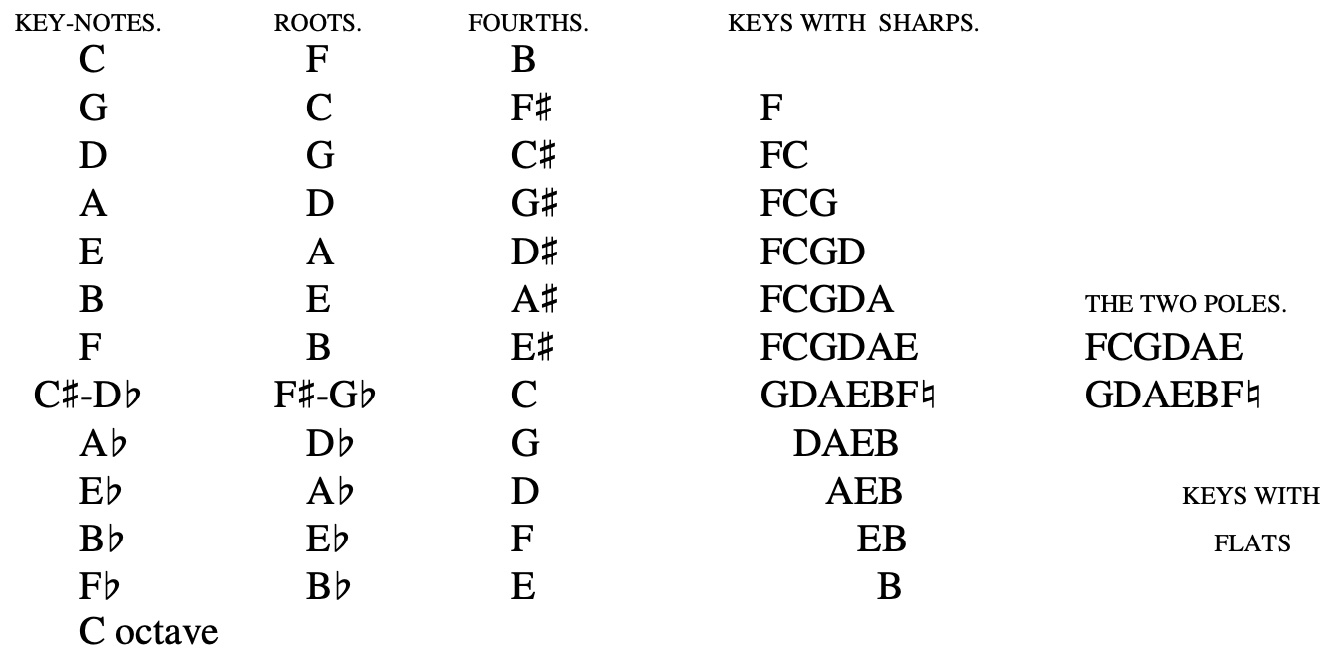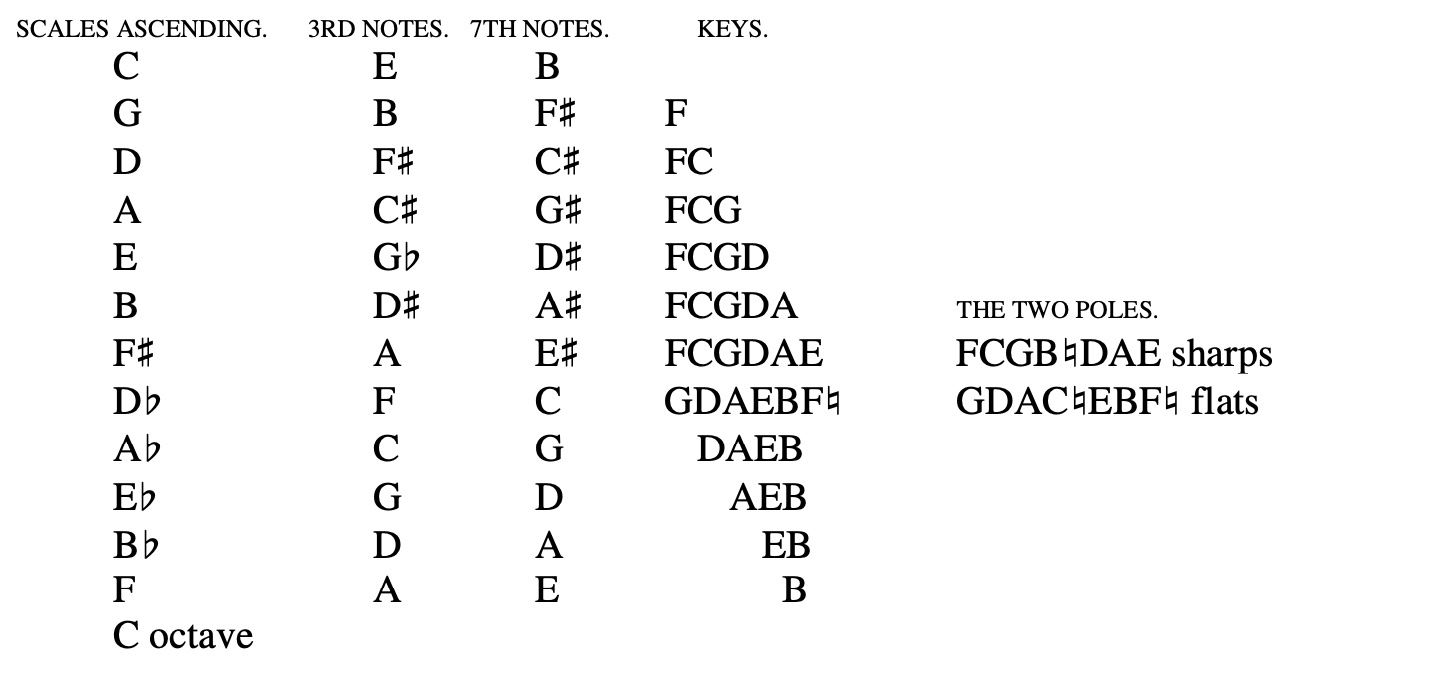Ramsay
The two notes required for the scale of
E minor are the F# of G, and the D of C major;
for B minor, the C# of D, and the A of G major;
for F# minor, the G# of A, and the E of D major;
for C# minor, the D# of E, and the B of A major;
for G# minor, the A# of B, and the F# of E major;
for D# minor, the E# of F#, and the C# of B major. [Scientific Basis and Build of Music, page 90]
When Leonhard Euler, the distinguished mathematician of the eighteenth century, wrote his essay on a New Theory of Music, Fuss remarks - "It has no great success, as it contained too much geometry for musicians, and too much music for geometers." There was a reason which Fuss was not seemingly able to observe, namely, that while it had hold of some very precious musical truth it also put forth some error, and error is always a hindrance to true progress. Euler did good service, however. In his letters to a German Princess on his theory of music he showed the true use of the mathematical primes 2, 3, and 5, but debarred the use of 7, saying, "Were we to introduce the number 7, the tones of an octave would be increased." It was wise in the great mathematician to hold his hand from adding other notes. It is always dangerous to offer strange fire on the altar. He very clearly set forth that while 2 has an unlimited use in producing Octaves, 3 must be limited to its use 3 times in producing Fifths. This was right, for in producing a fourth Fifth it is not a Fifth for the scale. But Euler erred in attempting to generate the semitonic scale of 12 notes by the use of the power of 5 a second time on the original materials. It produces F# right enough; for D27 by 5 gives 135, which is the number for F#. D27 is the note by which F# is produced, because D is right for this process in its unaltered condition. But when Euler proceeds further to use the prime 5 on the middles, A, E, and B, and F#, in their original and unaltered state, he quite errs, and produces all the sharpened notes too low. C# for the key of D is not got by applying 5 to A40, as it is in its birthplace; A40 has already been altered for the key of G by a comma, and is A40 1/2 before it is used for producing its third; it is A40 1/2 that, multiplied by 5, gives C#202 1/2, not C200, as Euler makes C#. Things are in the same condition with E before G# is wanted for the key of A. G# is found by 5 applied to E; not E in its original and unaltered state, E30; but as already raised a comma for the key of D, E30 3/8; so G# is not 300, as Euler has it, but 303 3/4. Euler next, by the same erroneous methods, proceeds to generate D# from B45, its birthplace number; but before D# is wanted for the key of E, B has been raised a comma, and is no longer B45, but B45 9/16, and this multiplied by 5 gives D#227 13/16, not D225, as Euler gives it. The last semitone which he generates to complete his 12 semitones is B?; that is A#, properly speaking, for this series, and he generates it from F#135; but this already altered note, before A# is wanted for the key of B, has been again raised a comma [Scientific Basis and Build of Music, page 107]
The inner stave contains the chromatic scale of twelve notes as played on keyed instruments. The flat and sharp phase of the intermediate notes are both given to indicate their relation to each other; the sharpened note being always the higher one, although seemingly on the stave the lower one. The two notes are the apotome minor apart overlapping each other by so much; ?D is the apotome lower than C#; ?E the apotome lower than D#; F# the apotome higher than ?G; G# the apotome higher than ?A; and A# the apotome higher than ?B. The figures for the chromatic scale are only given for the notes and their sharps; but in the mathematical series of notes the numbers are all given. [Scientific Basis and Build of Music, page 120]
Hughes
The key-note C sounding from within itself its six tones to and fro in trinities, the tones written as notes in musical clef
—The trinities hereafter termed primaries and secondaries
—The seven of each of the twelve key notes developing their tones
—The order in which the tones meet, avoiding consecutive fifths
—Dissonance is not opposition or separation
—The use of the chasms and double tones is seen
—The isolated fourths sound the twelve notes
—Each double tone developes only one perfect major harmony, with the exception of F#-G?; F# as the key-tone sounds F? as E#, and G? as the key-tone sounds B? as C?
—The primaries of the twelve key-notes are shown to sound the same tones as the secondaries of each third harmony below, but in a different order
—All harmonies are linked into each other, . 23 [Harmonies of Tones and Colours, Table of Contents2 - Harmonies]
study of the natural sciences, as we progress, we find that "hills peep o'er hills, and alps o'er alps arise." As regards keyed instruments, it appears that the effect of those notes which act two parts, such as C# and D?, is rectified in some way so as to be perfectly attuned to the ideal of harmony within us. Again, the "Amen" sung by the choir in a cathedral may not be in accurate tune, but if nearly the correct intonation is sounded, after traveling along the aisles, the chords always return to the ear in perfect harmony, because the natural laws of music, assisted by the echoing power of the building, have attuned them to the perfect harmonical triad. If the "Amen" be too much out of tune, these laws decline to interfere, and there is no such helpful resonance.* [Harmonies of Tones and Colours, The Method of Development or Creation of Harmonies2, page 16]
We here trace the twelve harmonies developing in succession. Notice how exactly they all agree in their mode of development; also the use of the chasms between E and F, B and C. Remark also the beautiful results from the working of the double tones, especially C#-D?, and E#-F?, causing the seven tones of each harmony, when ascending, to rise one tone, and, descending, to reverse this movement. F#-G? is the only double tone which acts as F# when a key-tone, and G? when the root of D?. The root of each harmony is the sixth and highest tone in each succeeding harmony, rising one octave; when it is a double tone, it sounds according to the necessity of the harmony. The intermediate tones are here coloured, showing gradual modulation. The isolated fourths (sounding sevenths) were the previously developed key-tones; these also alter when they are double tones, according to the necessity of the harmony. Beginning with B, the isolated fourth in the harmony of C, the tones sound the twelve notes of a keyed instrument, E# being F?, and the double tones, some flats, some sharps. [Harmonies of Tones and Colours, Combinations of dissonance, rests, page 24]
Examine C# in musical clef as an example of double tones only developing each one major harmony. C# sounds neither B nor E, but C and C#, F and F#. [Harmonies of Tones and Colours, Combinations of dissonance, rests, page 24]
The Major Key-note of C is here shewn developing its trinities from within itself, veering round; C and the other 11 developing their trinities in musical clef. Below each is the order in which the pairs meet, avoiding consecutive fifths. Lastly, C# is seen to be an imperfect major harmony; and G?, with B as C?, make the same harmony as F#. The intermediate tones of sharps and flats of the 7 white notes are here coloured in order to shew each harmony, but it must be remembered that they should, strictly, have intermediate tints. [Harmonies of Tones and Colours, The Major Keynote of C, page 24c]
ON a keyed instrument only twelve are major key-notes, but as the double tones C#-D? and F#-G? are roots, there are fourteen different chords. The fourteen that are roots are written in musical clef. As an example of the major chords in the different keys, we may examine those in the key of C. A major fifth includes five out of the seven of its key; with the third or central note it is the threefold chord, or fourfold when the octave note is added. Including the silent key-notes, a threefold chord embraces eight, or, counting the double tones, not including E#, eleven. The first and second chords of the seven of the harmony are perfect major chords in the key of C; the central note of the third chord, being #C-?D, is a discord. The first pair of fifths in the scale, with its central note, is a chord of the key; if we include the octave, the last pair of fifths, with its central note, is the same chord an octave higher than the lowest chord of the seven. Of the chords written in musical clef of the twelve keys, the octave chord is only written to C, the seven of each having two chords and the scale one, thirty-six in all, or forty-eight if the octave chords are added. Notice how the chords of each seven and the chord of its scale are altered. [Harmonies of Tones and Colours, Diagram V - The Chords of the Twelve Major Keys, page 27a]


THE same laws are followed here as in the development of the major scales. In that of A, F, the sixth note, has risen to F#, in order to meet B, which has previously sounded. In descending, the seventh note, B, falls to B?, in order to meet F, which has also previously sounded. The notes, ascending or descending, always follow the harmony of their key-note, except when rising higher or falling lower to meet in fifths. We may here trace the twelve, the ascending scale sounding the fifth harmony higher than its key-note, and, in descending, sounding the fifth lower harmony. The four pairs of each scale are written at the end of the lines. If we strike the twelve scales as they follow in succession, the thirteenth note being the octave of the first, and leader of a higher twelve; having gained them six times, at the seventh they gradually rise (though beyond the power of a keyed instrument) into the higher series of seven octaves, and again, in descending, they fall lower, and are linked into the lower series of seven octaves. Nine notes of any ascending minor scale may be struck without the necessity of modulating beyond the fifth harmony. For example, in the scale of A, its tenth note, C#, rises to meet the sixth note, which has previously sounded. In descending, E?, the eleventh note, meets B?, the seventh note, which has previously sounded. The scale of A may be traced veering round by reference to Diagram IX., beginning with A, and carrying the four lowest notes an octave higher, F rising to F# in ascending, B falling to B? in descending. [Harmonies of Tones and Colours, Diagram XI - The Twelve Minor Keynotes with the Six Note of Each, page 36a]
See Also
